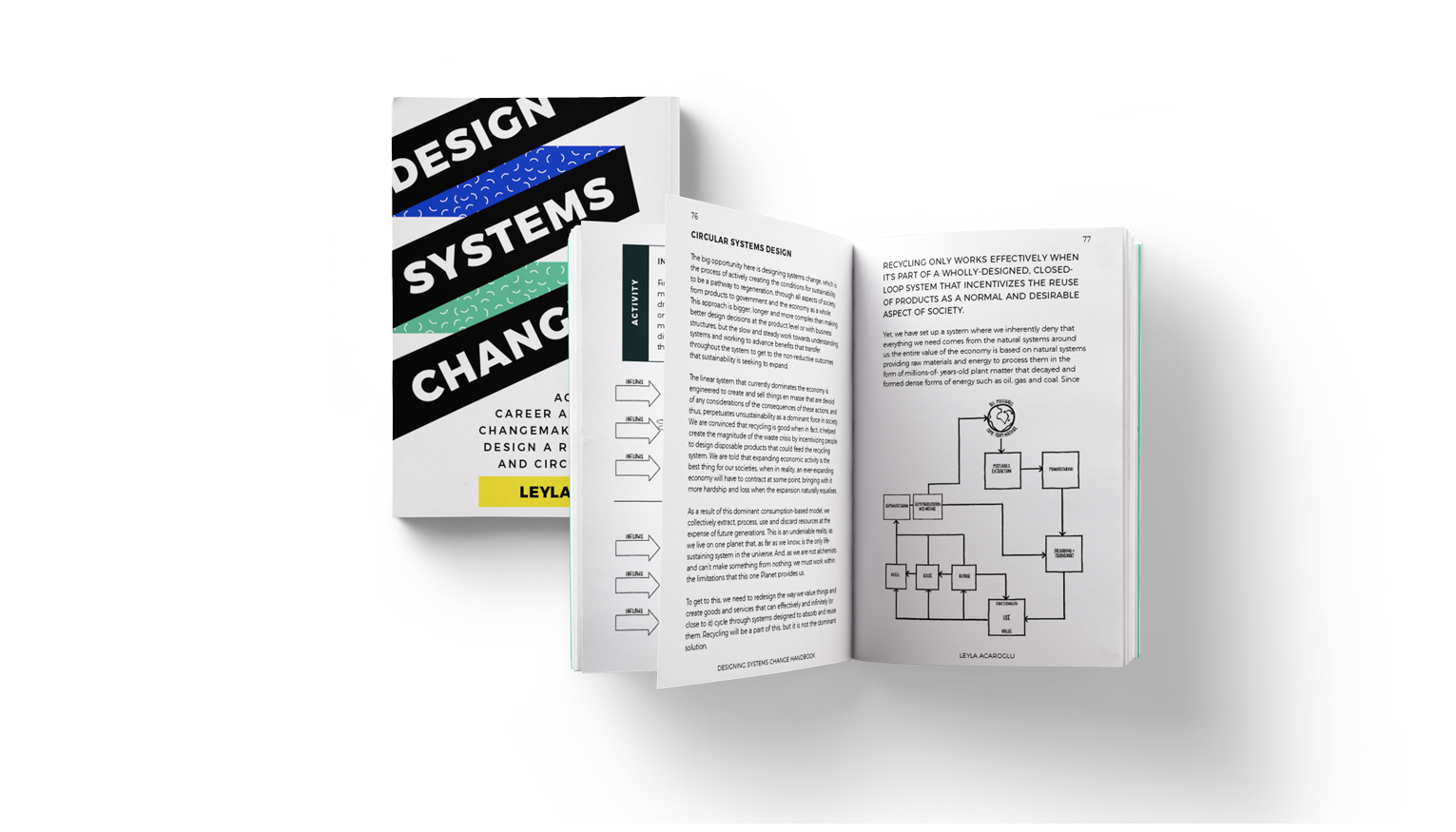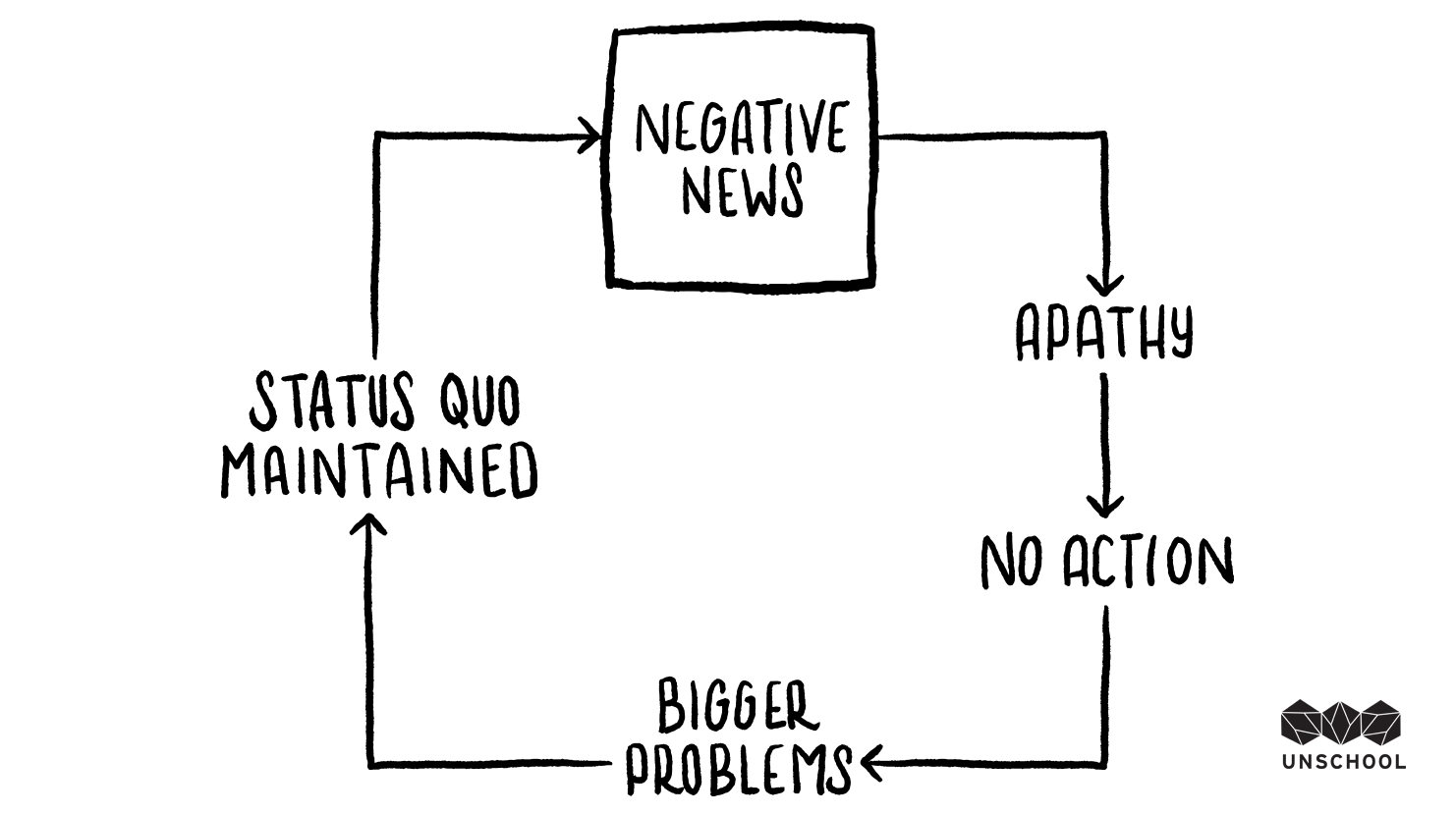Have you read any of our handbooks on making change? Leyla has written one each year since she started the UnSchool in 2014. The series titles include Make Change: A Handbook for Creative Rebels and Change Agents, Tips & Tricks to Facilitating Change, Disruptive Design: A Method for Activating Positive Social Change by Design, Circular Systems Design: A Toolkit for the Circular Economy, and now the fifth one in the series, Design Systems Change: How to activate your career as a creative changemaker and help design a regenerative, circular future.
The new handbook will be released on March 16, 2020 and includes an in-depth exploration of agency-building tools for activating a career of creative changemaking. Packed with new insights and ideas on how to expand your sphere of influence and contribute to the transition to a circular, regenerative future, this handbook is also a workbook, complete with interactive reflections and actions to help expand your capacity to make change.
The new Design Systems Change Handbook is out in March!
In the next few journal articles, we will share excerpts from the upcoming handbook from each of the three main sections (Design, Systems and Change), along with an extensive introduction to Taking Action.
This week, we dive into the introductory section on how to activate your agency by sharing with you one of our favorite parts. If you want to be one of the first to read the full 190+ pages, then you can pre-order it now, and it will be sent to your inbox in a digital format as soon as it's launched on March 16th!
Expert from, Design Systems Change, By Leyla Acaroglu
Introduction
Design is a powerful social influencer that shapes and scripts our experience of the world; we now live in a time where each and every day we interact with a world entirely designed by humans, for humans. Scientists now argue that we have entered into a new geological epoch called the Anthropocene. One of the main drivers of this shift to a world where humans influence every other living thing on the planet is design — the design of technology, of consumer goods, of scientific discoveries, of our lives. Design is everywhere.
The broader concept of design encompasses our planning and intent to dictate and control the way the world works. Humans have been doing this now for eons, but before the Industrial Revolution, where we unlocked the power of fossil fuels, change was confined to the slower changes that nature does organically.
For example, the plants we eat today were adapted each generation by farmers selecting the best-performing ones and changing the way they bear fruit for us; these changes were painstakingly slow. But now we have accelerated the rate of change thanks to technological development, and in doing so, we have greatly accelerated the changes to the systems that sustain life on Earth. We have designed a world exclusively for human needs, and unless we design it better so that we work within the systems that nature provides all that we need to live, then we will end up designing ourselves out of here!
Just as it can accidentally make a mess, design can also be a catalyst for positive and significant change. This is because, at its core, design is about creative problem solving and forming something new that works better than the past version.
Currently, so much of what is created is done so without the understanding of the impacts or the intent to create outcomes that are mutually positive for us and the planet. As a result, we end up living with impacts in which the externalities are ignored and the consequences are often unintended, but nonetheless momentous. So much of what we do in the economy is not accounted for in any way. These are known as externalities, and we often have no idea of how things like pollution are embedded in anything, like a pair of socks or what social costs were paid by the farmers who helped get us our morning coffee. Giant problematic systems like waste and pollution are the products of poorly-designed human systems.
There is no waste in nature; instead, the waste product from one system is the food and fuel for another. Everything is interconnected and optimized to thrive.
It’s obvious to most that we live in a complex and chaotic world with constant technological and social changes. Humans have done an incredible job at creating an array of design and technology solutions to work around the chaos, make our lives more comfortable, increase convenience and ease of living and prolong our lives. Yet many of these designed solutions come with entangled, complicated consequences, most of which are invisible to the human mind.
We consume things ignorant of the impacts their creation causes and are selectively blind to the impacts their subsequent waste will create. Design helps to sell us things that reinforce many of the problems that currently exist. We have created a linear production system with cheap efficient manufacturing where waste is a normal part of our lives now. This is what we need to redesign — the way we meet our needs so that we get beautiful, elegant solutions that are regenerative rather than destructive. We need to design out waste as we know it.
Collectively, we also rely on a linear thought process that fits within a linear world. This system of simplification allows for exploitation as the fundamental components of a successful economy. This is increasingly creating alarming and catastrophic outcomes, allowing us to see how we have designed ourselves into the current status quo, and thus providing a pathway for us to design ourselves out. Design can transcend linear function and provide an interwoven systems approach fundamental to inspiring and enacting change.
Paradoxical to the environmental crises at hand, we live in one of the safest times in all of human history. By many metrics, we are better off as a species now than any generation before us, due to food security, global diplomacy, advances in medicine, mass agriculture and efforts to alleviate poverty.
Yet despite this incredible progress, it comes at a significant cost to the future, as many people now maintain a stressed-out, negative perspective of the world, much of which the media reinforces that society and the planet as a whole are destined for a bleak future. Indeed, our fears will become a reflection of what we do today unless we all work to design a different trajectory.
Ask yourself — if not you, then who?
The future is undefined; it is made up of all our actions today.
And, yes, there are many complex problems at play in the world around us. And, yes, all of these complex problems need creative solutions from skilled people. And, yes, you are one of these people.
Why is it that some will take action, contribute to activating change, question the status quo, be willing to be different and rebel against the things that they know to be wrong, and others will not? Why do some humans passively accept what is and blame others for the things they don’t like?
There are many possible answers to these rhetorical questions. One is the cycle of inaction, whereby apathy leads to inaction. But courage, convocation, compassion, curiosity and sheer tenacity are some skills that we can all foster to overcome the apathy and activate our agency to participate in creating a future that overcomes the challenges of the past and ensure that the solutions we put in place today are not the problems of tomorrow.
The Cycle of Inaction
From the climate catastrophe to homelessness, the plastic waste crisis, the opioid epidemic, the Sixth Great Extinction, deforestation, childhood obesity, and the Anthropocene, there are many significant challenges awaiting creative minds to contribute to changing them. We can live in a post-disposable world if we design out waste; we can break the cycle of addiction by creating social systems that enable support. Plastic can play a part in our lives and not pollute the planetary systems if we design higher value products and create closed-loop systems to capture them. These are endless systems change solutions just waiting to be uncovered and emerge new ideas.
The reality and the magnitude of the problems at play can be overwhelming, especially to a mind unequipped with the tools for understanding the systems that create and sustain the problems to begin with. We live in a time of great technological change, where we can get information instantaneously and where that information can be tailored to us very specifically, playing on our fears, convincing us to consume, making it hard to escape the problem cycle.
With all of these issues prominently on display through social and traditional media, it’s easy to get sucked into a negativity bias that disables our ability to act. We know that negative news sells and that pessimistic viewpoints drum up sensational headlines that get heartbeats pounding, fear flowing and people feeling paralyzed.
With our emotional state being constantly milked day-in-day-out, it’s no wonder human perception can quickly become filled with negativity, pessimism and inaction.
This state of mind can easily reinforce apathy into inaction, which, in turn, reinforces the problems at play, as when people opt to not take part in changing the systems — this just enables the status quo to persist. We need to find ways of busting through the feedback loop of inaction!
Next week, we will share an excerpt from the Design section, so stay tuned!
This is really juicy brain food!











